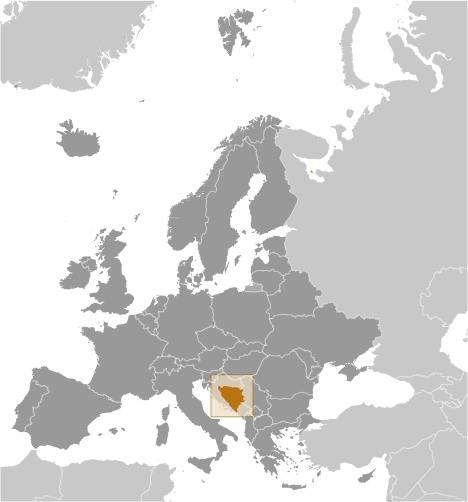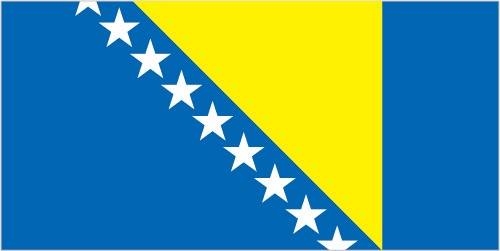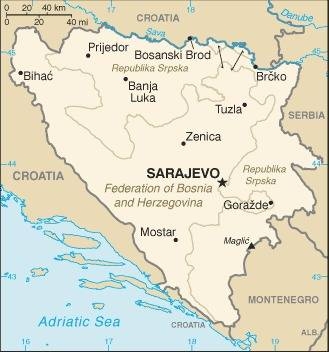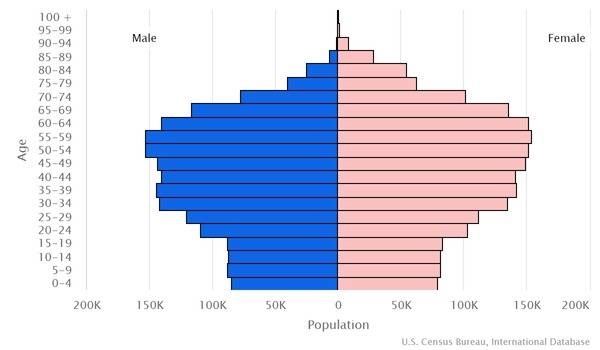Country Summary




Introduction
Background
Bosnia and Herzegovina declared sovereignty in October 1991 and independence from the former Yugoslavia in March 1992. On 21 November 1995, in Dayton, Ohio, warring parties initialed a peace agreement that ended three years of interethnic civil strife (the final agreement was signed in Paris on 14 December 1995).
Geography
Area
total: 51,197 sq km
land: 51,187 sq km
water: 10 sq km
Climate
hot summers and cold winters; areas of high elevation have short, cool summers and long, severe winters; mild, rainy winters along coast
Natural resources
coal, iron ore, antimony, bauxite, copper, lead, zinc, chromite, cobalt, manganese, nickel, clay, gypsum, salt, sand, timber, hydropower
People and Society
Population
3,816,459 (2022 est.)
Ethnic groups
Bosniak 50.1%, Serb 30.8%, Croat 15.4%, other 2.7%, not declared/no answer 1% (2013 est.)
Languages
Bosnian (official) 52.9%, Serbian (official) 30.8%, Croatian (official) 14.6%, other 1.6%, no answer 0.2% (2013 est.)
Religions
Muslim 50.7%, Orthodox 30.7%, Roman Catholic 15.2%, atheist 0.8%, agnostic 0.3%, other 1.2%, undeclared/no answer 1.1% (2013 est.)
Population growth rate
-0.22% (2022 est.)
Government
Government type
parliamentary republic
Capital
name: Sarajevo
Executive branch
chief of state: Chairman of the Presidency Zeljka CVIJANOVIC (chairman since 16 November 2022; presidency member since 16 November 2022 - Serb seat); Zeljko KOMSIC (presidency member since 20 November 2018 - Croat seat); Denis BECIROVIC (presidency member since 16 November 2022 - Bosniak seat)
head of government: Chairman of the Council of Ministers Zoran TEGELTIJA (since 5 December 2019)
Legislative branch
description: bicameral Parliamentary Assembly or Skupstina consists of:
House of Peoples or Dom Naroda (15 seats - 5 Bosniak, 5 Croat, 5 Serb; members designated by the Federation of Bosnia and Herzegovina's House of Peoples and the Republika Srpska's National Assembly to serve 4-year terms)
House of Representatives or Predstavnicki Dom (42 seats to include 28 seats allocated to the Federation of Bosnia and Herzegovina and 14 to the Republika Srpska; members directly elected by proportional representation vote to serve 4-year terms); note - the Federation of Bosnia and Herzegovina has a bicameral legislature that consists of the House of Peoples (58 seats - 17 Bosniak, 17 Croat, 17 Serb, 7 other) and the House of Representatives (98 seats; members directly elected by proportional representation vote to serve 4-year terms); Republika Srpska's unicameral legislature is the National Assembly (83 directly elected delegates serve 4-year terms)
Economy
Economic overview
import-dominated economy; remains consumption-heavy; lack of private sector investments and diversification; jointly addressing structural economic challenges; Chinese energy infrastructure investments; high unemployment; tourism industry impacted by COVID-19
Real GDP (purchasing power parity)
$47.05 billion (2020 est.)
Real GDP per capita
$14,300 (2020 est.)
Agricultural products
maize, milk, vegetables, potatoes, wheat, plums/sloes, apples, barley, cabbages, poultry
Industries
steel, coal, iron ore, lead, zinc, manganese, bauxite, aluminum, motor vehicle assembly, textiles, tobacco products, wooden furniture, ammunition, domestic appliances, oil refining
Exports
$6.81 billion (2020 est.)
Exports - partners
Germany 14%, Italy 12%, Croatia 11%, Serbia 11%, Austria 9%, Slovenia 8% (2019)
Exports - commodities
electricity, seating, leather shoes, furniture, insulated wiring (2019)
Imports
$9.71 billion (2020 est.)
Imports - partners
Croatia 15%, Serbia 13%, Germany 10%, Italy 9%, Slovenia 7%, China 6% (2019)
Imports - commodities
refined petroleum, cars, packaged medicines, coal, electricity (2019)
Exchange rates
konvertibilna markas (BAM) per US dollar -
Page last updated: Wednesday, November 16, 2022
